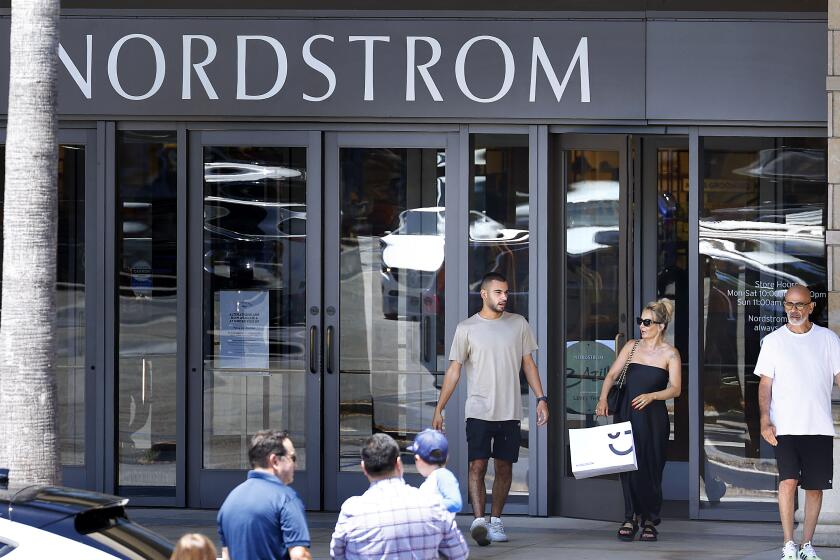Inflation rate highest since 1991
- Share via
WASHINGTON — The government delivered a triple dose of bad news for consumers Thursday that roughly added up to this: If your wallet seems thinner than it used to be, it’s not your imagination.
Real earnings are in decline. Consumer prices are on the rise. And there are signs that more job losses may be on the way. Despite the recent decline in oil prices, many economists expect the situation for consumers to get worse before it gets better.
Things are not getting any better for Hubert Evans. In the last month, the Albertsons supermarket in Baldwin Hills where he’s a meat department manager reduced his hours to 40 from 48 a week. That means his earnings are falling, even as the prices for the groceries his store sells rise, along with other goods.
“This year, everything about the economy went haywire, and it’s making it really rough. I can’t remember anything like this,” Evans said.
Consider the numbers the government released Thursday. Consumer prices surged 0.8% in July from the month before and chalked up a 12-month inflation rate of 5.6%, the Labor Department said Thursday.
That’s the highest rate of annual inflation since 1991. At the same time, workers’ earnings are shrinking.
The department said workers’ average earnings, adjusted for inflation, fell 3.1% in July from a year earlier. Real earnings have declined for 10 straight months, government data show.
“The last time we saw a decline like this was in the recession of 1991,” said Nigel Gault, chief U.S. economist at Global Insight, an economic forecasting firm in Lexington, Mass.
But the view on Wall Street was more positive. Many investors expect inflation to ease soon because the prices of oil and other commodities have tumbled in recent weeks -- declines that occurred too late to show up in July consumer prices. The Dow Jones industrial average rose 82.97 points, or 0.7%, on Thursday to close at 11,615.93. The bond market, which is especially sensitive to inflation fears, was calm.
However, the problem for consumers is “they are not even running in place. They are moving backward,” said Joel Naroff, president of Naroff Economic Advisors.
That’s the experience of Raquel Miranda of Los Angeles, who was shopping for a swimsuit at Kohl’s in Alhambra with her 5-year-old daughter.
“We’re investing our money in gas and groceries, so the extra stuff like clothes and shoes is really a luxury,” Miranda said.
The high inflation puts the Federal Reserve in even more of a bind, said economist Ken Beauchemin, also of Global Insight.
It could raise interest rates to help curb inflation, but it doesn’t want to hinder an already-sputtering economy, he said.
“Now that the tidal surge in energy and other commodity costs is showing unmistakable signs of turning up in consumer prices at large, the Fed finds itself pushed further into the corner,” Beauchemin said. “The recent report on retail sales coupled with today’s report indicates that a dip in real consumer spending is now underway.”
Meanwhile, the job outlook is cloudy. Unemployment hit a four-year high of 5.7% in July and signs are accumulating that August may be worse.
New claims for unemployment insurance are on the rise, reaching 460,000 last week and 450,000 this week, the Labor Department reported Thursday. Both were well above recent averages.
Continuing unemployment claims have hit 3.4 million -- the highest level since late 2003, said Gary Bigg, an economist with Bank of America in New York. That “indicates that jobs remain hard to find and that labor demand is soft,” Bigg said.
Some economists see glimmers of hope in the housing market.
The National Assn. of Realtors reported Thursday that the pace of home sales has picked up in recent months, a sign that falling prices have drawn some buyers back into the market. Some of the sharpest increases in sales volume were seen in areas with the sharpest price declines, including Southern California, the association reported.
“The market is working. The process seems to be going forward at a faster pace than people had anticipated. I would think that with a little bit of luck, the fourth quarter should be better,” said UCLA economist Lee Ohanian.
Another bright spot is falling fuel prices. The average U.S. price of a gallon of regular was $3.77 on Thursday, according to AAA, down from $4.11 a month ago. Economists said the July inflation rate probably did not catch the full effect of declines that began at the end of last month.
“Energy prices do seem to be coming down a bit. So I’m hopeful that going forward we won’t see as much of an increase,” Ohanian said. “That decline will translate into lower gasoline prices and lower prices across the board.”
Other economists were less sanguine. They noted that even excluding food and fuel, consumer prices appear to be on the rise across the economy.
Consumers have already cut their gasoline use, and fuel prices are still biting into other consumer spending. The Commerce Department reported Wednesday that July retail sales fell 0.1%, the first decline in five months.
That’s also not news to Evans, who has been tightening his own belt. He now leaves his SUV in the garage and takes the bus to work. Weekend dinners with friends are becoming increasingly rare. And he’s buying cheaper cuts of meat and store-brand groceries.
His customers are doing the same. “They’re still buying sirloin, it’s just more of the cheaper grade,” Evans said. “They’re really selective now. They just won’t go out and buy like they used to.”
--
tiffany.hsu@latimes.com
--
Times staff writer James Gerstenzang contributed to this report.
More to Read
Inside the business of entertainment
The Wide Shot brings you news, analysis and insights on everything from streaming wars to production — and what it all means for the future.
You may occasionally receive promotional content from the Los Angeles Times.











